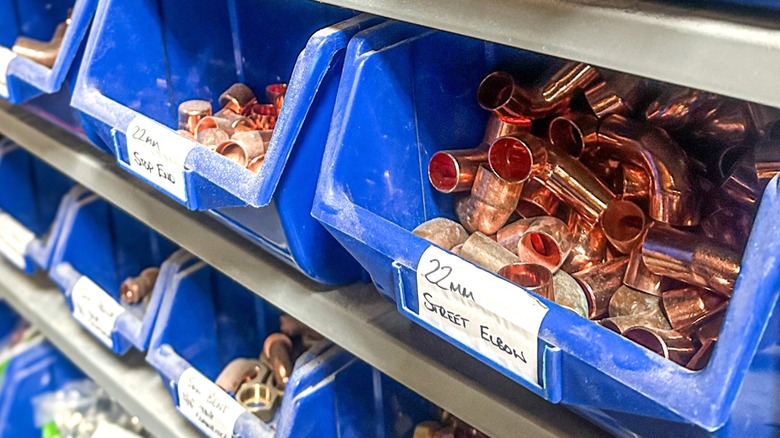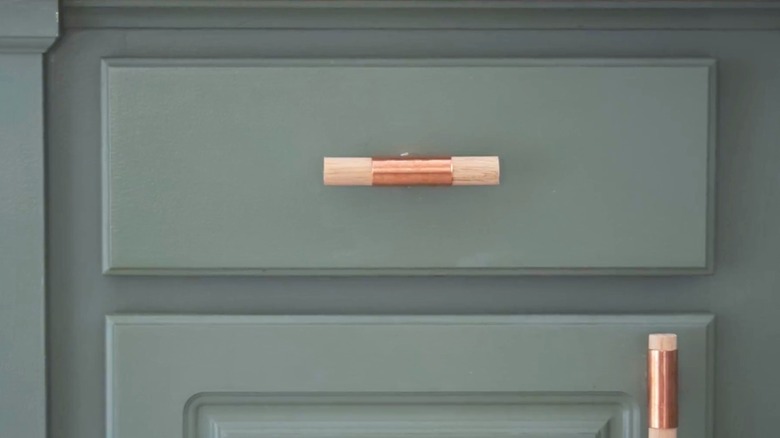Repurpose Old Pipes To DIY Elegant Drawer Pulls On A Budget
There are a ton of elements to think about when you're trying to choose the perfect design style for your space. What color are you painting the walls? What furniture are you buying for a given aesthetic? How many extra lighting fixtures do you need? However, one element that you might not immediately consider, despite there being a ton of variation in your local hardware store, is cabinet (or cupboard/drawer) knobs. There's nigh-endless options for your interior design, from classic, rounded wooden knobs to sleek, modern metal pieces with geometric aesthetics. One DIY project suggested by TikTok user @kkiernan would involve making your own budget-friendly drawer pull bars using some old copper tees and wooden dowel rods.
Beyond the aesthetic draw, drawer pulls are a great option to make storage features more accessible for more people. Drawer pulls were designed to have a bigger grip space and work with less force, making them more ideal than the often smaller, lightweight design of traditional cabinet knobs. This DIY project is also cheap to take on if you need to buy new pieces, with tee pipes costing as little as $3 a pop and wooden dowels going for about as much. There's plenty of room to customize your new drawer pulls as well, allowing them to fit spaces as diverse as your kitchen cupboards, bedroom drawers, and bathroom cabinets on the same basic design.
How to build your DIY drawer pulls using pipe tees and wooden dowels
The first and most important part of this DIY drawer pull project is going to be selecting the right material sizes. If you go with a ½-inch copper tee, for example, you'll want the dowels to be a slightly smaller width — something like ⅝ of an inch. The dowel needs to fit snugly inside the pipe so it doesn't slip when you pull open your drawers. While the length of the dowel can vary, a good rule of thumb is to shoot for a pull measuring about ⅓ of the width of the drawer. Depending on your preference (and available tools), you can choose a miter saw or table saw for your DIY project, but it's important that you have leftover lengths of dowel to work with after cutting the main bar.
That main bar is going to connect two tee pipes (make sure the offshoot bottom end of the "T" faces the same direction on both). Then, you'll want another dowel piece about an inch or so long on the opposite end of the main bar so it appears to stretch straight through. Another small piece of wood barely long enough to come out of the pipe should be inserted into each bottom end, as this will offer a place for screws to anchor when you drill the pull bar into place from the inside of your drawer. The right sized dowels should snugly fit into place, but if you're worried about pulling the bar apart, you can apply super glue or other strong adhesives on the inserted dowel end.
A DIY drawer pull has plenty of room for customization
This is an easy DIY for a novice maker looking to design unique accents for the home, as long as you follow appropriate safety guidelines when working with electric saws, including wearing protective eyewear and a mask to avoid dust inhalation. It's also great for flexing your creative muscles. Your copper tees can be spray-painted, and your dowels can be stained various colors depending on the aesthetic of your living space. If you're planning to insert these drawer pulls into your kitchen or bathroom, you will also want to waterproof the wood with an all-natural ingredient like beeswax to protect them from ambient moisture. For swinging cabinets, it's worth noting that this same DIY design can be built vertically as well as horizontally.
You also don't have to strictly stick with the look of a wooden dowel extending all the way through your tee pipes. The dowels could be augmented with custom details like hanging charms stuck to the ends, either purely for the sound of jingling as you open a drawer or to bring some good luck to the space. Alternatively, items like more traditional door knobs could be stuck on either end of the pull bar to cap off the DIY project in style. There's also room to swap out materials, going with plastic tee pipes or metal rods for different tactile feelings, though it may be harder to get metal pushed into a tight space compared to wood, requiring more of an exact size to fit.

